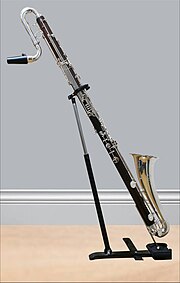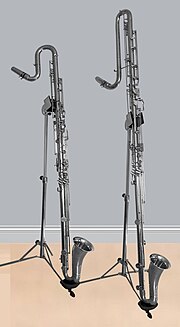
Back Kontraaltklarinette German Clarinette contralto French コントラアルトクラリネット Japanese Kontraaltklarinett NB
 A Contra-alto clarinet with range to low E♭ (right) in comparison with an Alto clarinet with range to low C. (Buffet Crampon/Dietz) | |
| Woodwind instrument | |
|---|---|
| Classification | |
| Hornbostel–Sachs classification | (Single-reeded aerophone with keys) |
| Playing range | |
 The sounding range is G1 to B♭4. | |
| Related instruments | |





The contra-alto clarinet, E♭ contrabass clarinet, is a large clarinet pitched a perfect fifth below the B♭ bass clarinet. It is a transposing instrument in E♭ sounding an octave and a major sixth below its written pitch, between the bass clarinet and the B♭ contrabass clarinet.
The contra-alto clarinet is often used in clarinet choirs[1] and ensembles of clarinets and saxophones. It may also be present in a wind band. The repertoire for contra-alto clarinet in the symphony orchestra is limited. In ensembles it is usually used in unison with the other woodwind instruments, such as (bassoon, bass clarinet and contrabass clarinet), or it plays the lower octave in addition. [citation needed]
- ^ Weerts, Richard K. (1964). "The Clarinet Choir". Journal of Research in Music Education. 12 (3): 227–230. doi:10.2307/3343790. JSTOR 3343790. S2CID 144443887. Retrieved 2 October 2021 – via JSTOR.
© MMXXIII Rich X Search. We shall prevail. All rights reserved. Rich X Search